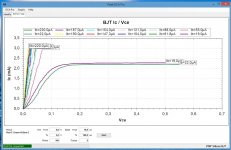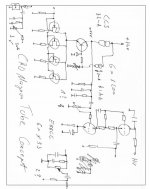Just thought, what about the quasi-sat behavior of some pairs like the MJL outputs from ONSemi and the D4xH11? I am still working with my high-current Kmultipliers and knowing which outputs were suitable for low-Vce would be helpful. In a C-multiplier application, good quasi-sat behavior is critical for filtering.
Is quasi-sat at 1-10A feasible?
Is quasi-sat at 1-10A feasible?
Here are D44H11, D45H11.
I can not measure at low Vce with more then ca.200uA base current.
I am still learning to interpret the data but i would say that over the range i can measure the match is good. Hfe is 110 in one gender and 130 in the other.
I can not measure at low Vce with more then ca.200uA base current.
I am still learning to interpret the data but i would say that over the range i can measure the match is good. Hfe is 110 in one gender and 130 in the other.
Attachments
I have being playing with the Cro Magnon circuit for a while and i think the result will not be better then the Paradise for example. On the other hand i made a tube transimpedance RIAA that sounds if not better but very attractive. Especially when i listen at medium and low volumes there is a beauty that is addictive. It does not slam as hard but it has tremendoes space and liquidity. The problem with this stgae is the input tube. It really has to be selected hard for low noise and low microphonics. Even if i find matched pairs in emmission and idle i have to throw away 80 to 90%. That can get very expensive because the tube i use costs at least 20,-€ a piece if you can find decent ones. Then it occured to me hat we can use the J-Fet Cro Magnon input stage with the Mu Follower output stage of my tube RIAA. That Mu Follower has a very good performance. Frequency response is up to 1,5MHz, output impedance is 140 Ohm and gain is x 33 so we only need an aditional x 30 or so in the input stage. I use the JJ E88CC with very good results. That tube is in production and i have a good source that selects the tube for me without much aditional cost. The input stgae will now be much more easy to design because we do not need the incredible one stage gain any more. You could say that this is now a two stage design but on the other hand we safe the buffer so it is not more complex. I found a decent high voltage power supply that is ready made. On lokation i use simple RC filtering. The result is super quiet.
In the next days i will publish the design as far as i have it. Still the challenge is out to make a low noise, low drift CCS for the input stage, so Michael, Frans, AS etc. i need your expertise. I have already talked to Frans that a P-channel Mosfet source could be a good choise. I also have two designs, one Bipolar, one depletion MosFet that works.
In the next days i will publish the design as far as i have it. Still the challenge is out to make a low noise, low drift CCS for the input stage, so Michael, Frans, AS etc. i need your expertise. I have already talked to Frans that a P-channel Mosfet source could be a good choise. I also have two designs, one Bipolar, one depletion MosFet that works.
Last edited:
The system is playing. We listen to the triangular speakers with modified SEAS wideband drivers. There is no crossover and the speakers are undamped and open in the bottom.
A rough ride but obviuosly a lot of fun.
Foursome/fs18
A rough ride but obviuosly a lot of fun.
Foursome/fs18
Some people asked me how my amplifier is developing, for them this link 🙂
Flickr: Search F.d.W.'s photostream
Flickr: Search F.d.W.'s photostream
I have build an input stage that COULD work. DC conditions are rock solid so now i can try how much gain i can get out of it. I need a gain of about 300x to 400x at DC.
For whom it may concern (or be useful 🙂) http://technologyinterface.nmsu.edu/Fall09/Fall09/011.pdf
Nice way to put it 🙂
For whom it may concern (or be useful 🙂) http://technologyinterface.nmsu.edu/Fall09/Fall09/011.pdf
Tanks a lot for that 😀
Almost got spontaneous brain burn out caused by math symbols and 2 remaining brain cells being almost 50 proof.
I was going to use this
Transistor matching
and would welcome same advice please
If I place a 100 Hom's resistor where the picture shows the A meter
I can measure volt drop across the resistor Yes?
What would be the best value for the resistor?
You have to make sure that the resistor does not drop too much voltage.
Say you use a 9V battery and the Fet has an Idss of 10mA. You want to drop 2 V.
That makes the resistor U/I = R
2 / 0.01 = 200 Ohm
Your 100 Ohm whould drop 1V. That is ok too.
Say you use a 9V battery and the Fet has an Idss of 10mA. You want to drop 2 V.
That makes the resistor U/I = R
2 / 0.01 = 200 Ohm
Your 100 Ohm whould drop 1V. That is ok too.


